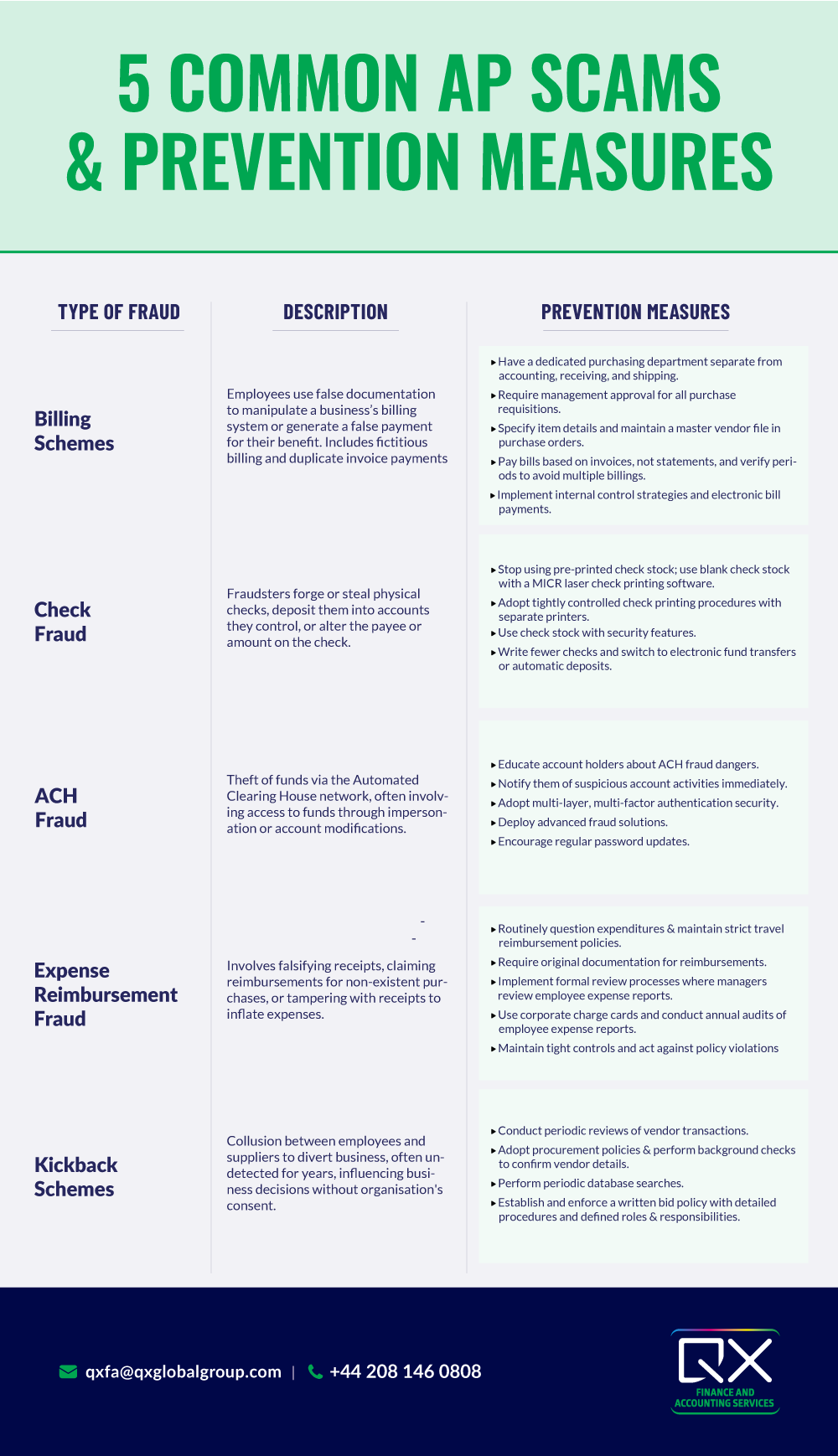Topics: Accounts Payable Automation, Accounts Payable Optimisation, Accounts Payable Process
5 Ways Accounts Payable Departments Can Combat the Most Common Frauds
Posted on April 04, 2022
Written By Divya Ramaswamy

Skim the news app or thumb through a newspaper, and chances are you’ll bump into a story or two about economic frauds or crime. Wherever there is money, there is a crime. Frauds are risks to which no business is immune. Even sophisticated, well-established tech giants like Facebook and Google have fallen prey to accounts payable fraud. Sadly, more than four in 10 U.K. businesses remain unaware of the risks associated with such crimes.
Accounts Payable frauds continue to occur across industries worldwide, despite the best efforts of financial officers and controllers. They disrupt businesses and can be notoriously challenging to detect, especially if you aren’t aware of the different types of AP frauds or the latest AP fraud detection & protection methods.
Accounts Payable (AP) departments are often perceived as easy prey and are thus prone to scams and malicious attacks. As payments are usually processed via AP departments, they become a prime target. But being hyperaware of your company’s business transactions and implementing several measures to curtail and respond to fraudulent activities can ensure the protection of your financial assets.
WHAT IS ACCOUNTS PAYABLE FRAUD?
Accounts payable fraud refers to the common kind of deception or criminal activity targeting a business’s AP department involving outgoing payments. AP frauds can be committed internally by the employees, externally by vendors, both, or perhaps even by an outside party looking to access your business’s AP systems. AP fraud is all too common and causes hundreds of millions in losses.
Accounts Payable: Everything You Need To Know
Want to know more about Accounts Payable? Check out our ultimate guide and optimize payables for your business.
Read Our Free Guide
Let’s take a close look at the most common AP scams and understand what steps accounting teams can take to prevent them.
1. BILLING SCHEMES
The most common type of AP fraud involves an employee using false documentation to manipulate a business’s billing system or generate a false payment for their benefit. Two common billing schemes include fictitious billing and duplicate invoice payments.
In the former, the fraudster creates a fictitious vendor that bills the company for payment, which is then diverted to the fraudster. A fake name and a post office box are all it takes to accomplish this. Whereas when it comes to the latter, the fraudster manipulates the vendor’s account, causing double payment and then diverts the amount to a bank account under their control.
Ways to deter and prevent:
- Have a dedicated purchasing department exclusive to the payment function. It must be independent of the accounting, receiving, and shipping departments.
- All purchase requisitions to be approved by the management.
- Purchase orders should specify item descriptions, quantities, qualities, prices and dates, and the company should maintain a master vendor file.
- Ensure that bills are paid based on an invoice, never from a statement; plus, always verify periods to avoid multiple billings.
- Implement internal control strategies within accounting functions and use electronic bill payment with a built-in workflow.
2. CHECK FRAUD
This is one of the most frequently reported types of fraud where the fraudsters forge or steal physical checks and deposit them into accounts they control. Sometimes, they even change the company’s accounting system code to hide it. In some cases, the amount a check is made out for is adjusted, or the payee is changed.
Tech-savvy criminals can reproduce hundreds of realistic forged checks in just a matter of hours if they have access to basic corporate account information. Check fraud hits a company’s bottom line, but it also disrupts the business.
While preventing check fraud isn’t simple, you can take many steps to protect your business.
- Stop using pre-printed check stock and opt for blank check stock alongside a MICR laser check printing software.
- Adopt tightly controlled check printing procedures and ensure that your company’s printer is different from your check printer.
- Use check stock with security features that prevent copying or mimicking.
- Write fewer checks and switch to electronic fund transfers or automatic deposits. This is one of the most effective ways to wipe out check frauds.
3. ACH FRAUD
This refers to the theft of funds via the Automated Clearing House (ACH) financial transaction network. Many financial institutions use the ACH network to handle bill payments, direct deposits, and cash transfers. As common as this type of transaction is, it is also prone to fraud.
This type of AP fraud occurs when an employee or a hacker gain access to funds as they pass through an automated clearing house used to process electronic fund transfers. A routing number and a checking account number are all it takes to commit this fraud. The fraudsters also start engaging in vendor impersonation fraud, wherein they edit a current vendor profile to send payments to their account. ACH scammers target small to mid-sized companies and lower-income individuals who apply for loans frequently.
Ways to prevent:
- Warn and educate account holders about the dangers of ACH fraud.
- Notify them of suspicious account activities immediately.
- Adopt multi-layer, multi-factor authentication security.
- Deploy advanced fraud solutions.
- Banks & credit unions should encourage account holders to update their passwords regularly.
4. EXPENSE REIMBURSEMENT FRAUD
From falsifying receipts, claiming reimbursements for purchases that were never made or for complimentary rides or meals offered by hotels, submitting expenses that never happened, and producing fake or tampered receipts using online receipt makers or design tools, this type of AP fraud can be blatant.
Sometimes, these fraudsters collaborate with vendors to obtain receipts for purchases that never happened. Also, when organisations have expense policies that don’t require receipts for expenses under a certain amount, dishonest employees tend to take advantage of such a loophole and submit expense reports without receipts.
Safeguards to prevent this fraud:
- Routinely questioning expenditures.
- Maintaining travel reimbursement policies and guidelines.
- Demand submissions of original documentation.
- Adopt formal review processes wherein department managers review employee’s reports.
- Implementing the use of corporate charge cards.
- Conduct annual audits of employees’ expense reports.
- Maintain tight controls, and act against offenders who falsify or violate expense reports.
5. KICKBACK SCHEMES
This is one of the most damaging types of AP fraud, where employees and suppliers collaborate to influence a business decision without the organisation’s knowledge or consent. It can last years without detection, resulting in significant losses to victimised businesses. This type of fraud involves collusion between employees and vendors to divert business to the latter in exchange for money or value-based arrangements to the former.
As these schemes involve multiple employees, there is an increased opportunity to circumvent a company’s internal control procedures. And if the fraudster is a manager, they influence to facilitate it through the company’s normal accounting processes.
While whistle-blowers help detect most kickback schemes, companies can initiate the following processes:
- Conduct periodic reviews of vendor transactions to spot unusual activities.
- Adopt procurement policies and background checks to confirm vendor ownership, physical address, website presence, contact numbers, etc.
- Perform periodic database searches.
- Establish and enforce a written bid policy with detailed procedures and defined roles & responsibilities.

RED FLAGS THAT AP DEPARTMENTS SHOULD LOOK FOR:
As most businesses do not recoup their losses from fraud, it becomes even more crucial to prevent it beforehand. Closely watching for red flags can help identify and prevent fraud.
- Invoices listing addresses the same as that of an employee, those that only include a P.O. Box number and those with even-numbered totals are absolute red flags.
- Invoices that look photocopied, in sequence and with critical details missing, such as contact details, tax ID number and purchase order number.
- Missing checks and signatures that look suspicious.
- Vendor master files enlisting inactive or duplicate suppliers. Also, watch for the same suppliers with new contracts or a larger one and invoices with address mismatch.
- Complaints from vendors/suppliers pertaining to late payments or non-payments when your records say payment has already been made.
- Suspicious employee behaviour includes living beyond their means, excessive gambling, abrupt lifestyle changes, unusually close associations with customers or vendors and unwillingness to share duties.
- Multiple invoices paid together or on the same date and spikes in invoice volume.
- Rounded dollar amounts, prices that seem unusually high or low, and payments consistently falling just under the amount requiring authorisation.
- Frequent complaints about specific processes or personnel.
- An Excessive number of adjusting entries without reasons.
UNCOVER AP FRAUD WITH BENFORD’S LAW
Benford’s Law, also known as the law of first digits, or the phenomenon of significant digits, is often applied when looking to identify fraud as it has to do with the expected occurrence of leading numbers in a dataset. It is the finding that the first digits of the records of the most varied sources do not display a uniform distribution but rather are arranged in such a way that the numeral one is the most frequent, followed by digits 2, 3, and so in a successively decreasing frequency down to 9.
Fraud examiners use this law to determine whether datasets are genuine. For instance, if an expense report lists 100 line items whose distribution of the first numeral differs significantly from the distribution outlined in this law, there is a reason to suspect that the employee could have forged it.

Image Credit: Wikipedia, https://en.wikipedia.org/wiki/Benford%27s_law#/media/File:Rozklad_benforda.svg
So, where do you stand?
Are you a leader in detecting and preventing AP frauds? Or do you see areas of improvement that could be addressed as a matter of urgency? Either way, you ought to act now. Proactively conduct regular audits, watch for red flags, and check bank statements regularly. Conduct background checks, educate your employees on threats posed by phishing attempts and check & update the vendor master files regularly.
You can also partner with QX today to ensure security segregation of duties and protect your business from payment fraud. Our Accounts Payable outsourcing services have helped clients improve the entire payables process by delivering higher accuracy and decreased operation costs via process excellence, standardised AP practices, and strategic automation.
Are you curious to see how you can prevent fraud by outsourcing your Accounts Payable process? Contact us for a personalised consultation or call us on 0845 838 2592.
Book a Consultation
We hope you enjoyed reading this blog. If you want our team to help you optimise your payables process, improve supplier relationships, reduce costs and transform your business operations, just book a call.
Originally published Apr 04, 2022 02:04:15, updated Dec 27 2024
Topics: Accounts Payable Automation, Accounts Payable Optimisation, Accounts Payable Process








